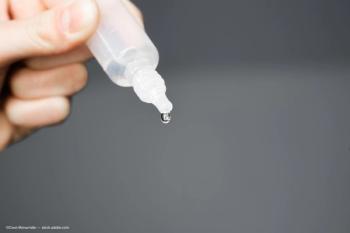
The hyphema that keeps on giving
Persistent bleeding in a glaucoma patient with neovascular glaucoma after metastatic renal carcinoma requires a range of surgical methods to treat.
By Vanessa Caceres;Reviewed by JoAnn A. Ciaconi, MD
Large hyphemas in patients with glaucoma and persistent bleeding can be challenging to treat. JoAnn A. Giaconi, MD, discussed a challenging case of a recurrent hyphema.
A male patient had metastatic renal carcinoma with a metastasis to the superior iris/angle that had received plaque brachytherapy five years earlier. The patient subsequently developed neovascular glaucoma four years after the plaque therapy, necessitating a Baerveldt tube shunt, with persistent neovascularization of the iris, and a small layered hyphema of a couple of millimeters in height.
The patient also was taking a multikinase inhibitor (sunitinib malate) for his cancer and bleeding is a known side effect. Over the next year of follow-up, his vision dropped to bare hand motion level because of the enlargement of the hyphema, which grew to fill the entire anterior chamber.
Dr. Giaconi, associate clinical professor of ophthalmology, David Geffen School of Medicine UCLA, Stein Eye Institute, Los Angeles, and retinal colleagues took the patient to the operating room. The surgeons performed an anterior chamber (AC) washout, along with intracameral cautery of the regressed tumor. However, the patient’s AC quickly refilled with blood postoperatively.
Eight-ball hyphema
When Dr. Giaconi saw the patient postoperatively, the patient’s intraocular pressure (IOP) was over 50 mm Hg. “That wasn’t surprising considering the eight-ball hyphema,” Dr. Giaconi said.
An eight-ball hyphema is misnamed, as it is not a liquid hyphema, but rather a clot. “When I got to the OR, the one thing I didn’t want to do was pull on the clot,” said Dr. Giaconi, as that had initiated rebleeding with the first AC washout.
After viscodissection of the clot from the cornea, a vitrectomy of the clot was initiated in the central AC with an anterior vitrector. The eight-ball hyphema had the consistency of a gummy bear or congealed cheese, Dr. Giaconi described.
The clot would not come to the mouth of the vitrector to be cleared, so Dr. Giaconi adjusted settings, i.e., bottle height and dropped the cut rate greatly to facilitate progress. Although textbooks advise removing an eight-ball with a vitrector, using cut-irrigation/aspiration, that did not work in this case.
“I actually needed to aspirate a little bit of the clot toward the tip before it would cut and engage,” Dr. Giaconi said.
Consultation
Progress was slow to nil so a retinal surgeon was consulted. He recommended clearing the clot by pulling it from the eye. After pulling on the clot with forceps, “the hyphema that keeps on giving” started, Dr. Giaconi said.
“There was a lot of blood emanating into the chamber, most likely from the area with the regressed tumor,” she added.
Anterior vitrectomy was recommenced but “the visibility was poor because every time eye pressure went down, blood came in,” she said.
Multiple instruments were tried, additional incisions were made to approach the clot from different angles, and additional manipulation of the vitrector settings were made. About 1½ hours into the case, the visual axis was cleared and the inferonasal tube shunt was visualized.
“The problem was, I didn’t feel like I could stop here because I knew bleeding would continue and negate all the progress I’d painfully made,” Dr. Giaconi said.
Point to wrap up surgery
Tamponade of the eye was tried for a full 5 minutes. The bleeding recommenced. The tube was flushed to ensure there was no clot downstream in the patient’s Baerveldt implant.
“I did just a little more clean-up and then I decided to call it a day,” Dr. Giaconi said. “I didn’t think his cornea could handle all this surgery.”
Viscoelastic material was injected at the end of the case to help tamponade bleeding, but the AC was not filled with viscoelastic to avoid high pressures that would cause the patient headache.
Although vision was improved and the patient’s pressure was reasonable, in the IOP in high 20 mm Hg, over the subsequent few days, the patient’s eye looked similar to its preoperative appearance within a week.
Retinal oncology took him back to the OR, removed the clot, and resected the superior iris to remove the tumor.
“In hindsight, I’d maybe place my incisions in different locations, pull on the clot further away from the tumor location to loosen it, and have been even more patient with the vitrectomy process,” Dr. Giaconi concluded. “The gentleman does have a medical condition and was on drugs that cause bleeding. I don’t know if things would have turned out differently,”
JoAnn A. Giaconi, MD
This article was adapted from a presentation that Dr. Giaconi delivered at the 2016 Glaucoma Subspecialty Day, held prior to the 2016 American Academy of Ophthalmology meeting. Dr. Giaconi has no related financial disclosures.
Newsletter
Don’t miss out—get Ophthalmology Times updates on the latest clinical advancements and expert interviews, straight to your inbox.













































